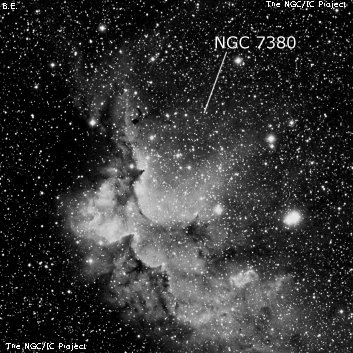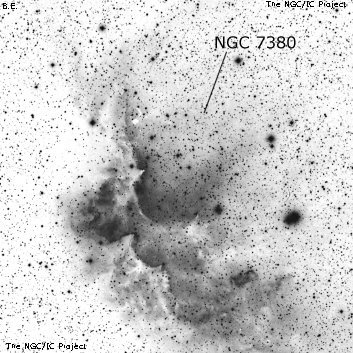NGC/IC Project Restoration Effort
(This is a very very beta version)
NGC7380


Basic Information
Location and Magnitude
Right Ascension: 22:47:21.0
Declination: +58:7:54
Constellation: CEP
Visual Magnitude: 7.2
Historic Information
Discoverer: Herschel C.
Year of discovery: 1787
Discovery aperture: 4.2
Observational
Summary description: Cl, pL, pRi, lC, st 9…13
Sub-type: III3pn
Corwin's Notes
=====
NGC 7380. First seen by CH in 1787, this cluster is quite a spectacular sight
on the DSS -- it is embedded in nebulosity, bright and dark. None of the
Herschel's mention the nebulosity, though some is bright enough that it could
be visible in rich-field telescopes.
JH has two observations of this. The first, in Sweep 211, has an RA one
minute of time too small (see NGC 7352 for another cluster in the same sweep
with a possibly problematic RA). His second position is for a double star on
the southwestern edge of the cluster, but his estimated diameter, ten
arcminutes is appropriate as is the rest of his note: "... a fine, p rich, L
cluster, 10' diam; stars 9...13 m." WH's position is closer to the center,
but is still southwest of the positions that Brian and I have estimated.
Steve's Notes
=====
NGC 7380
17.5" (10/30/99): at 100x with an OIII and UHC filter appears as a bright triangular-shaped nebulosity (Sh 2-142), 8'-10' diameter, superimposed on a rich grouping of stars (NGC 7380) within a rich Milky Way field. The brightest mag 8.5 star (very unequal double) is at the west vertex. Also a wide strip of nebulosity is attached near the SE vertex and extends to the SW. A dark band appears to separate this strip from the triangular patch. The surrounding region appears weakly nebulous and the "edge" can be traced with some certainty further the north.
17.5" (7/31/92): at 100x, about 40 stars in a 10' diameter. The brighter stars form a "V" or chevron pattern. The brightest star is at the west tip of the "V" and is an unequal double mag 8.6/13. The cluster appears to be encased in nebulosity especially from the mag 8.6 star to the star at the east tip of the "V". Using an OIII filter the nebulosity is quite prominent with some structure and encases the entire cluster. A lane of nebulosity oriented SW-NE extends beyond the cluster from the star at the east end of the "V" and nebulosity also extends west of the mag 8.6 star. The double star O·480 = 7.6/8.6 at 30" is in the field to the west.
13" (10/26/80): ~30-35 stars in a triangular outline, 10'-12' in diameter but not rich.



